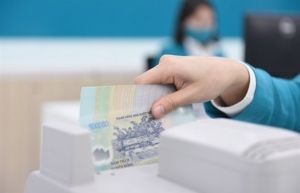Disbursement of assistance to be bolstered for enterprises
 |
| Enterprises in some sectors are requesting more support in terms of taxes and fees, Photo: Shutterstock |
The government last week issued a document to ministries and localities asking them to hurry deployment of the Programme on Socioeconomic Recovery and Development (PSRD) to spur on economic growth, generate more employment, and revitalise enterprises whose performance is waning.
“After one year of carrying out the PSRD, a large volume of work has been achieved. With the full enactment of guiding documents, the assistance package’s disbursed sum has hit an estimated sum of over VND84 trillion ($3.65 billion) which has supported individuals and businesses to recover their production activities,” stated a government resolution released at a March meeting on the national socioeconomic situation for Q1.
“However, a number of policies have expired with humble results and the transfer of resources from infeasible policies to other feasible policies remains slow,” the resolution admitted.
The $3.65 billion sum is equivalent to just under one-quarter of the initiative’s total value of $15 billion allocated by the National Assembly in January 2022. Meanwhile, the PSRD will officially expire later this year.
As of late February, for schemes on providing preferential loans via the Vietnam Bank for Social Policies, the bank disbursed all types of loans valued at $697.2 million under the PSRD. This included loans for purchasing computers and equipment for online study ($35.9 million); for purchasing social houses ($175.9 million); for employment assistance ($434.8 million); for non-state nurseries and primary schools ($8.4 million); and for inhabitants of ethnic minorities and in mountainous areas ($42.26 million).
When it comes to the package for supporting factory workers in housing rental, localities have disbursed about $162.8 million.
In extending tax payment and land rental, by late January about $2.28 billion was disbursed for exempting and decreasing taxes and fees. Tax payment and land rental worth $4.6 billion was extended – including just over $4 billion for extending the payment of VAT, corporate income tax, personal income tax, and land rental, and the remainder for extending the payment of special consumption tax for domestically produced or assembled automobiles.
Meanwhile, demands of businesses for more assistance from the policy remains substantial.
“We need to be supported further in terms of taxes and fees,” said Nguyen Viet Thang, vice director of a garment and textile company in Hanoi which is now bogged down in debt of nearly $870,000 as of Q1 this year. “Like many other businesses, we are now burdened by a raft of different types of taxes, as well as assorted fees such as commodity storage and transportation.”
According to the General Statistics Office, last year the number of businesses with halted operations hit 73,800, up 34.3 per cent on-year. The number of those with halted operations and waiting for dissolution reached 50,800, up 5.5 per cent; while the number of those having completed dissolution procedures sat at 18,600, up 11.2 per cent. On average, each month witnessed as many as 11,900 enterprises withdrawing from the market.
In Q1 of 2023, the number of enterprises with suspended operations reached 42,900, up 20.1 per cent on-year. The number of those awaiting dissolution is 12,800, up 13 per cent on-year.
Figures from the government showed that in Q1, the economy grew 3.32 per cent on-year, which was the lowest Q1 growth over the past 12 years. The agro-forestry-fishery sector grow 2.52 per cent, creating 8.85 per cent of economic growth; the construction and industrial sector declined 0.4 per cent, causing a 4.76 per cent reduction in growth; and the service sector climbed 6.79 per cent, responsible for 95.9 per cent of growth.
Low economic growth is threatening the implementation of other goals. It is calculated that for the economy to hit its targeted 6.5 per cent this year, it must grow 6.7 in Q2, 7.5 per cent in Q3, and 7.9 per cent in Q4. The growth rates for the remaining two quarters must be 1 and 0.8 percentage higher than the Q3 and Q4 growth scenario of set in early this year (6.5 and 7.1 per cent, respectively).
This would also mean the growth speed for Q3 and Q4 must be 2.26 and 2.38 times higher than the 3.32 per cent growth rate in Q1, deemed a very challenging scenario in the context that key impetuses for growth are weakening.
The PSRD was adopted by the National Assembly early last year as people and enterprises continued to suffer from pandemic restrictions. On a macro-view, it is expected to enable the economy to achieve a higher level of growth – at 6.5-7 per cent in the 2021-2025 period.
The PSRD embraces five key components, including re-opening the economy pertaining to enhancing medical capacity, and pandemic prevention and control; ensuring social welfare and employment; assisting enterprises’ recovery, cooperatives, and business households; developing infrastructure; and increasing institutional and administrative reform, and improving the investment and business climate. Moreover, another $434.8 million will be mobilised from non-state budget financial funds.
 | Leaders declare intention to up PSRD deployment Amid difficulties continuing to undermine the business community, the government is hurrying the deployment of the national hallmark socioeconomic recovery and development initiative in a bid to fuel enterprises’ performance and achieve desired economic growth. |
What the stars mean:
★ Poor ★ ★ Promising ★★★ Good ★★★★ Very good ★★★★★ Exceptional
Related Contents
Latest News
More News
- Businesses ramp up production as year-end orders surge (December 30, 2025 | 10:05)
- Vietjet chairwoman awarded Labour Hero title (December 29, 2025 | 13:06)
- How to unlock ESG value through green innovation (December 29, 2025 | 10:03)
- AI reshapes media and advertising industry (December 29, 2025 | 08:33)
- FPT and GELEX sign deal to develop blockchain tech for global markets (December 29, 2025 | 08:29)
- Vietnam’s GDP forecast to grow by 9 per cent in 2026 (December 29, 2025 | 08:29)
- Women entrepreneurs are key to Vietnam’s economic growth (December 29, 2025 | 08:00)
- Vietnam's top 500 value-creating enterprises announced (December 27, 2025 | 08:00)
- The PAN Group shaping a better future with ESG strategy (December 26, 2025 | 09:00)
- Masan Consumer officially lists on HSX, marking the next phase of value creation (December 25, 2025 | 13:20)

 Tag:
Tag:





















 Mobile Version
Mobile Version